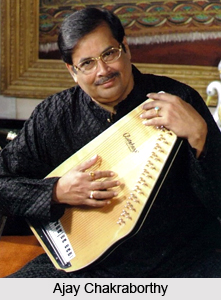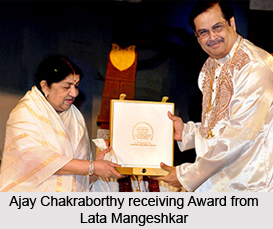 Pandit Ajay Chakrabarty has carved a distinct place himself in the realm of Indian classical Musical tradition. He has been reckoned as one amongst the most gifted and skilled classical vocalists that India has produced.
Pandit Ajay Chakrabarty has carved a distinct place himself in the realm of Indian classical Musical tradition. He has been reckoned as one amongst the most gifted and skilled classical vocalists that India has produced.
Early Life of Ajay Chakrabarty
In the year 1952, this illustrious classical vocalist was born in Kolkata. His parents recall that `he could sing before he could talk`. His parents have undergone severe hard times in their life time but this has not came to constrain before little Ajay Chakraborthy. Pandit Ajay Chakraborthy has been inducted to the music tradition with the hands of his father Shri Ajit Chakrabarty. Afterwards he received training under the maestros of Indian classical music like Late Kanaidas Bairagi, Pandit Jnan Prakash Ghosh and the Late Munawar Ali Khan. His career started prospering under the expert tutelage of Pandit Jnan Prakash Ghosh. In the year 1971, he started receiving training from Late Munawar Ali Khan, the son of the great Patiala Maestro Ustad Bade Gulam Ali Khan. Their repertoire has been instilled to Pandit Ajay Chakraborthy. And the journey of a genius of patiala gharana began.
Education of Ajay Chakrabarty
Pandit Ajay Chakraborthy obtained gold medal in BA Honours. He has also obtained gold medal in MA examinations of Rabindra Bharati University, Kolkata. By receiving singular distinction of becoming the first nominated Fellow from the Sangeet Research Academy, Calcutta, who has won gold medal, he has proved his brilliance. Sangeet Research Academy is one amongst the leading music institution of India consecrated to the `promotion of classical music in India and abroad`. Pandit Ajay Chakraborthy joined the institution as a scholar. But acknowledging his talent in the field of music within a few years he has been promoted to the post of Guru and member of the Expert Committee.
 Musical Career of Ajay Chakraborty
Musical Career of Ajay Chakraborty
Throughout his career time, Pandit Ajay Chakraborthy has bagged many `firsts and bests` to his credit. He has bagged the honour of being the first Indian Classical Vocalist who has performed in Pakistan on their invitation. Through his performances his audiences has always been magnetized. Acknowledging his extraordinary expertise, he has been conferred the first `Kumar Gandharva` award, which is considered as one of the most esteemed national award. This award is given for the Indian classical musicians who are under their forty-five years of age. In the year 1990, Pandit Ajay Chakraborthy has been conferred the President`s Award for the best male playback singer. He is the Indian classical vocalist of India, who for the first time has been conferred this award. He has also been conferred many State Awards for his performance in film songs. He has also fetched the honor of being the first Fellow who was given the Gold Medal from the Sangeet Research Academy, Kolkata.
Records and Albums for Ajay Chakraborty
Pandit Ajay Chakraborthy has released LP, cassette, and CD albums over fifty in India, Pakistan, Europe and USA. He has earned acclamation throughout the world even from those audiences who do not conceive or understand the language of the lyrics..
Pandit Ajay Chakraborty other than executing his gayaki also attempted to fill up the cultural gap that is there between India and the West. For this purpose he made musical tours in an extensive manner through out Europe and America. His main aim is to `transmute Indian vocal classical music in a universal idiom of feeling`. Pandit Ajay Chakraborty has established `Srutinandan`, a school of music, located in Kolkata - India with the aim `to impart practical knowledge of the basics of all forms of Indian vocal music to musically gifted young children in order that they may realize their potential as worthy artists who will perpetuate the rich musical tradition of India`.




















